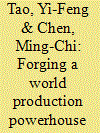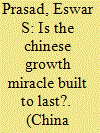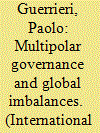| Srl | Item |
| 1 |
ID:
072164


|
|
|
| 2 |
ID:
086592


|
|
|
|
|
| Publication |
2009.
|
| Summary/Abstract |
Is the Chinese growth miracle - a remarkably high growth rate sustained for over two decades - likely to persist or are the seeds of its eventual demise contained in the policies that have boosted growth? For all its presumed flaws, the particular approach to macroeconomic and structural policies that has been adopted by the Chinese government has helped to deliver high productivity and output growth, along with a reasonable degree of macroeconomic stability. There comes a point, however, when the policy distortions needed to maintain this approach could generate imbalances, impose potentially large welfare costs, and themselves become a source of instability.
The traditional risks faced by emerging market economies, especially those related to having an open capital account, do not loom large in the case of China. In the process of securing protection against external risks, however, Chinese policymakers may have increased the risks of internal instability. There are a number of factors that could trigger unfavorable economic dynamics that, even if they don't rise to the level of a crisis, could have serious adverse repercussions on growth and welfare. The flexibility and potency of macroeconomic tools to deal with such negative shocks is constrained by the panoply of policies that has supported growth so far.
|
|
|
|
|
|
|
|
|
|
|
|
|
|
|
|
| 3 |
ID:
119403


|
|
|
|
|
| Publication |
2013.
|
| Summary/Abstract |
Direct dividend transfer programs are promising as an additional instrument to reduce inequality and increase the poverty-reducing powers of economic growth in resource-rich countries.
|
|
|
|
|
|
|
|
|
|
|
|
|
|
|
|
| 4 |
ID:
096249


|
|
|
|
|
| Publication |
2010.
|
| Summary/Abstract |
The deficiency of financial regulation and the presence of large macroeconomic global imbalances should be considered complementary interpretations of the global economic and financial crisis. The risk we face is that a new expansionary phase will bring back large and growing external imbalances, which will keep world growth on an unsustainable path. At the international level there is a classical 'collective action' problem to address since if export growth oriented strategies are pursued by all major countries they will generate a deflationary bias in world demand. This article explores how multilateral cooperation and international institutions can become reengaged with, and provides a meaningful device for addressing, these new issues and problems. It is necessary to restore shared rules of the game for international macroeconomic adjustment. This means endorsing a strengthened surveillance regime for the IMF in order to induce more compatible macroeconomic policies. In this regard, the IMF should have enforcement rule incentives and mechanisms, otherwise we are going to repeat past negative experiences where peer pressure did not produce significant results.
|
|
|
|
|
|
|
|
|
|
|
|
|
|
|
|
| 5 |
ID:
120878


|
|
|
|
|
| Publication |
2013.
|
| Summary/Abstract |
This paper examines the question of whether a country's exchange rate policy choices are influenced by membership in preferential trade agreements (PTAs). We argue that PTAs, by constraining a government's ability to employ trade protection, increase its incentives to maintain monetary and fiscal autonomy in order to manipulate the domestic political economy. Consequently, we contend that countries are less likely to adopt or sustain a fixed exchange rate when they have signed a PTA with their "base" country-the country to whom they have traditionally fixed the currency or the major industrial country to whom they have the most extensive trade ties. Likewise, countries that have signed a "base" PTA also tend to have more depreciated/undervalued currencies, as measured by the level of the real exchange rate. Using data on 99 countries from 1975 to 2004, we find strong support for these hypotheses. These findings shed light on the complex relationship between different types of macroeconomic policies in the contemporary world economy. More broadly, they speak to the question of whether international agreements are credible commitment mechanisms when close policy substitutes exist at the domestic level.
|
|
|
|
|
|
|
|
|
|
|
|
|
|
|
|